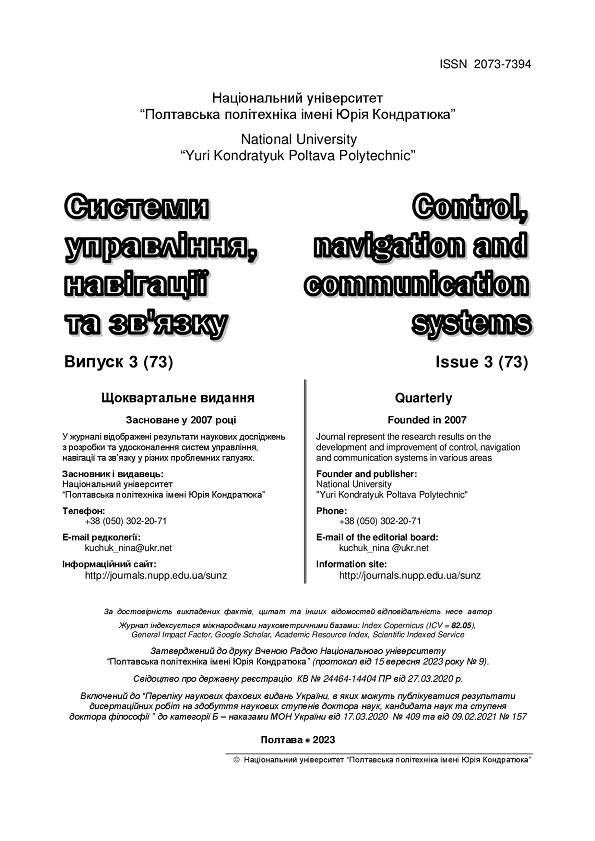MATHEMATICAL MODEL OF THE RELIABILITY OF THE CS OPERATING IN THE MNS BASED ON THE USE OF THE PRINCIPLE OF PASSIVE FAULT TOLERANCE
DOI:
https://doi.org/10.26906/SUNZ.2023.3.144Keywords:
probability of failure-free operation, mathematical model, modular number system, reliability model, computer system, passive fault toleranceAbstract
The analysis of the state and prospects for the development of modern computer systems (CS) showed that the problem of increasing fault tolerance, which is the basis of reliability, cannot be effectively solved based on the use of the traditional binary positional number system without worsening the rest of the technical and economic indicators of the CS. In the positional numeral system (PNS), the execution of an arithmetic operation involves the sequential processing of the digits of operands according to the rules determined by the content of the operation, and cannot be completed until the values of all intermediate results are sequentially determined taking into account all the connections between the digits. Thus, PNSs, in which information is presented and processed in modern computers, have a significant drawback – the presence of inter-bit relations, which impose its imprint on the methods of implementing arithmetic operations, complicate the equipment and limit the speed. The results obtained as a result of the conducted research and previous positive results show the perspective of using the modular number system (MNS) to increase the fault tolerance and reliability of the CS. The use in the CS as a number system of the MNS allows to positively solve the scientific and applied problem of ensuring the fault tolerance of the CS without reducing the user productivity of information processing with significantly less, than in the PNS, the additionally introduced amount of equipment. It is proposed to use the probability of no-failure operation as the main indicator for assessing the reliability of the functioning of the CS. Using a formalized model of fault tolerance of the CS, a mathematical model of the reliability of the CS operating in the MNS was investigated and obtained based on the use of the principle of passive fault tolerance. A mathematical model of CS fault tolerance, which, unlike the known ones, is based on the use of the properties of modular arithmetic, by taking into account the peculiarities of the functioning of information processing paths in the MNS, allows increasing the reliability of the CS. The study of the model showed that with an increase in the multiplicity of redundancy, the reliability of the CS in the MNS (with two control bases) increases to 25% compared to the tripled CS using the positional number system.Downloads
References
Mohan P. V. A. Residue Number Systems: Theory and Applications. Birkhäuser Basel, Switzerland, 2016, 351 p. ISBN-10:331941383X, ISBN-13: 978-3319413839.
Krasnobayev V., Kuznetsov A., Yanko A., Koshman S., Zamula A. and Kuznetsova T. Data processing in the system of residual classes. Monograph. ASC Academic Publishing, 2019, 208 p. ISBN: 978-0-9989826-6-3, ISBN: 978-0-9989826-7-0 (Ebook).
Krasnobaev V., Kuznetsov A., Kiian A., Kuznetsova K. Fault Tolerance Computer System Structures Functioning in Residue Classes. Proceedings of 2021 11th IEEE International Conference on Intelligent Data Acquisition and Advanced Computing Systems: Technology and Applications (IDAACS), Cracow, 2021, pp. 471-474. doi: 10.1109/IDAACS53288.2021.9660919.
Liu R., Li L., Yang, Y. Performance Residual Based Fault Detection for Feedback Control Systems. IEEE Transactions on Circuits and Systems II: Express Briefs 68 (2021) 3291-3295. doi:10.1109/TCSII.2021.3062718.
Fairclough H. & He, Linwei & Asfaha, Tekle & Rigby, Sam. (2023). Adaptive topology optimization of fail-safe truss structures. Structural and Multidisciplinary Optimization. doi: 66. 10.1007/s00158-023-03585-x.
Geng Z., Han M., Bao W., Xie W. New Submodule Topology Based Fault Tolerance for Modular Multilevel Converters. IEEE Transactions on Power Delivery, 2023. pp 1-12. doi: 10.1109/TPWRD.2023.3237891.




